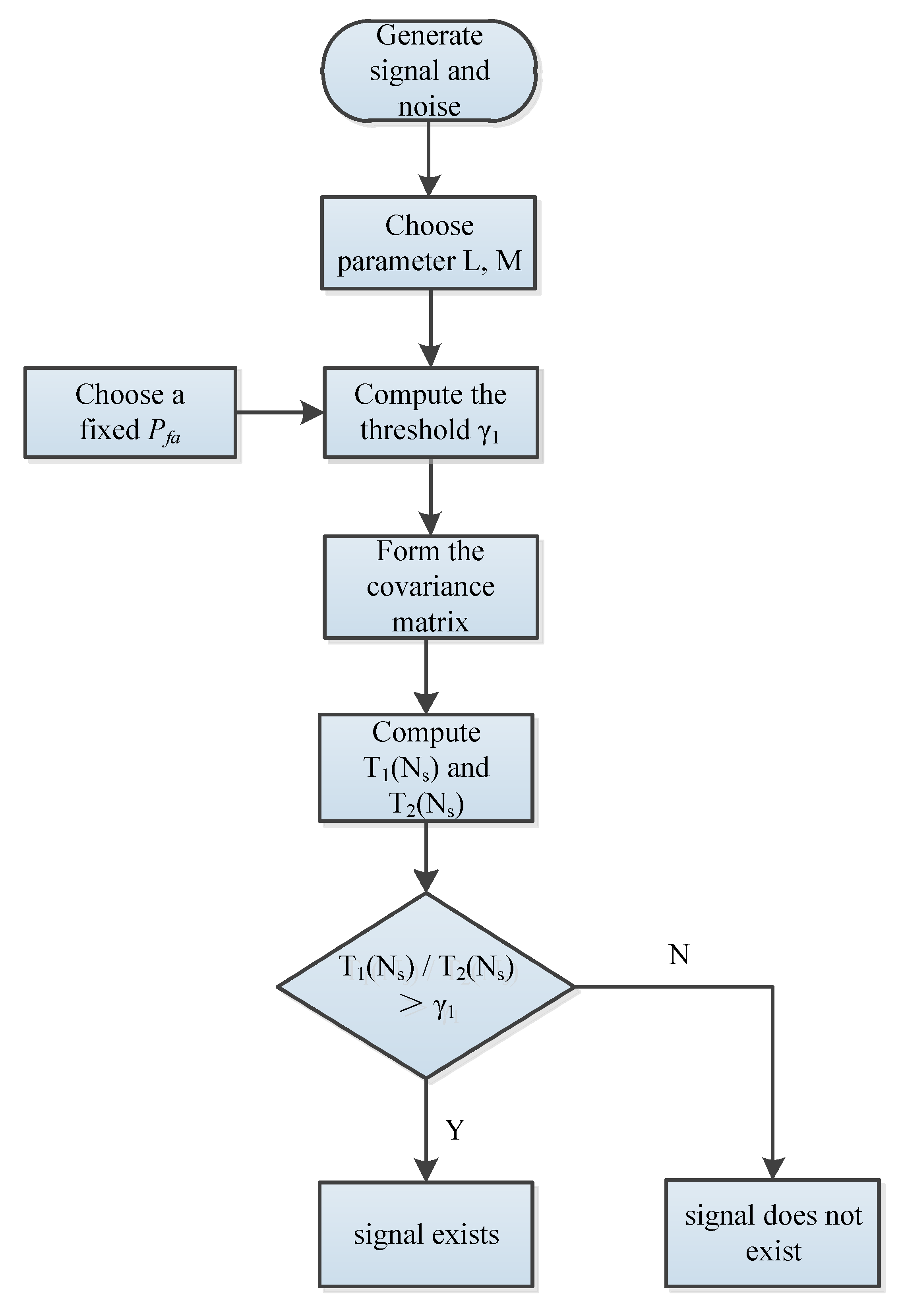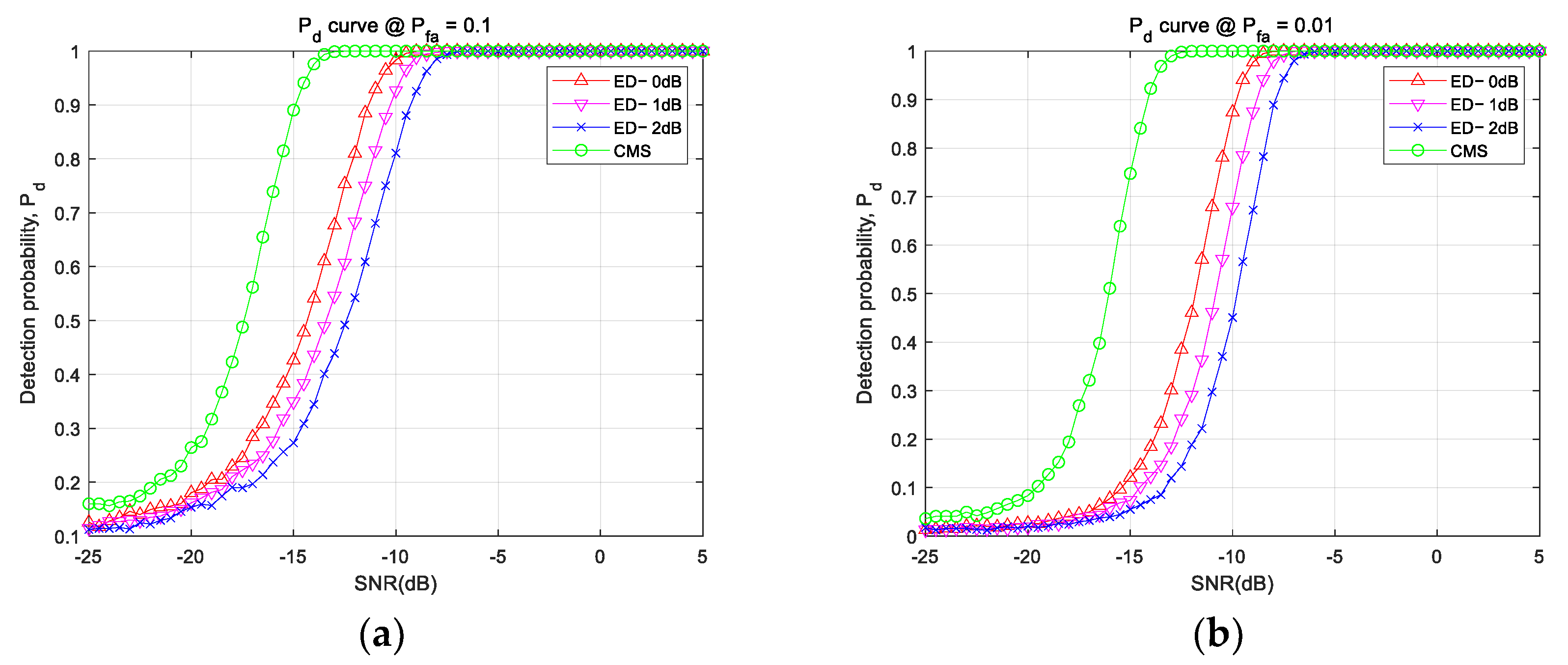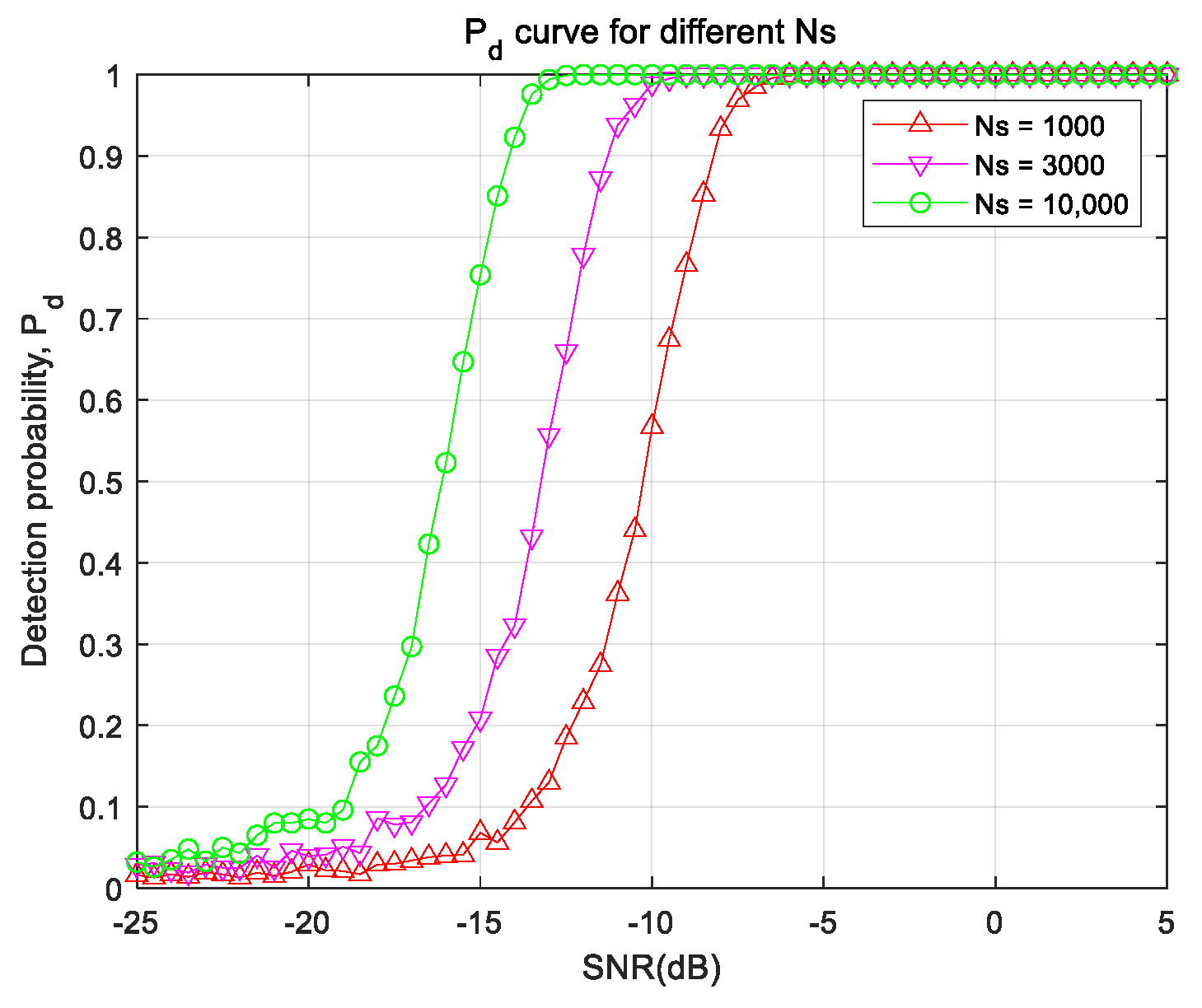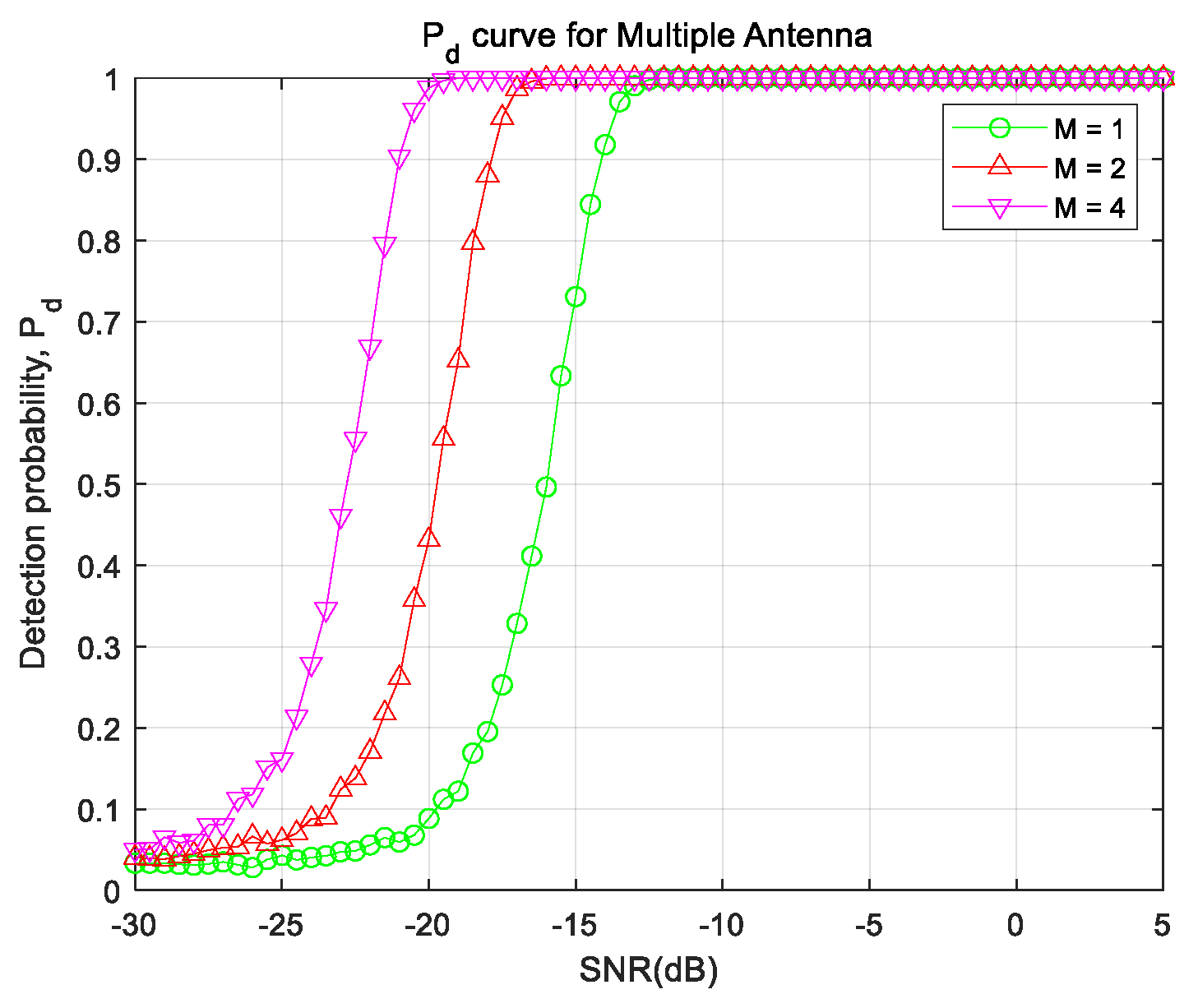1. Introduction
When a spacecraft enters the atmosphere at a hypersonic velocity, the air will be ionized at the shock front created by the high-speed vehicle; thus, the surface of the aircraft is enveloped by a hypersonic plasma sheath. The sheath then absorbs, scatters, and reflects microwaves, resulting in a severe decrease in or even a complete loss of the strength of radio-frequency (RF) signals between the reentry vehicle and the ground, which is called a “communications blackout” or simply a “blackout” [
1].
A blackout may lead to many problems—especially the attenuation of the signal—that will cause the loss of data telemetry and/or the loss of vehicle control, etc. Moreover, the fluctuation of the electron density will lead to a significant level of signal uncertainty. To evaluate the attenuation of the signal, conventional methods usually use microwave diagnostics, including microwave reflectometry [
2,
3,
4,
5], antenna impedance [
6,
7,
8], and/or transmission coefficient [
9] diagnostics. These methods are based on reflection and/or transmission coefficients measurements. However, the diagnosed results suffer from inaccuracy when the radio wave frequency is not close to plasma frequency [
4]. In addition, these methods usually need prior information about noise, as without such prior information, the diagnosed results are difficult to estimate, especially under a low signal-to-noise ratio (SNR) condition.
To overcome these difficulties, it is necessary to directly investigate sensing (or detecting) methods for low SNR signals. However, few signal-sensing schemes in a hypersonic plasma sheath environment are publicly reported. On the other hand, signal-sensing schemes are widely used in other fields. Based on the symmetry to signal-sensing methods in the cognitive radio field, we can adopt such methods as a reasonable reference. In the cognitive radio field, spectrum/signal-sensing schemes are widely used, such as the energy-detection method [
10,
11,
12,
13], the matched-filtering method [
14,
15], and the cyclostationary-detection method [
16,
17].
Let us compare these methods. The matched-filtering method requires knowledge of the waveforms and channels of the detected signal, which makes it difficult for practical implementation [
18]. The cyclostationary-detection method requires knowledge of cyclic frequencies of the detected signal, with high computational complexity. The energy-detection (ED) method does not need any information about the detected signal and, thus, it is robust with respect to unknown dispersive channels. However, like microwave diagnostics methods, energy detection relies on the knowledge of accurate noise level information. Thus, inaccurate estimation of the noise level leads to an SNR wall and high probability of false alarm [
19].
In recent years, blind detection algorithms, which need no information on source signal or noise level, have become an active research area. These methods include eigenvalue-based, wavelet-based, and covariance-based sensing method. Eigenvalue-based methods use the eigenvalues of the sample covariance matrix to detect signals, including the maximum–minimum eigenvalue (MME) detector [
20], the energy-to-minimum eigenvalue (EME) detector [
21], and the arithmetic-to-geometric-mean (AGM) detector [
22]. Wavelet-based methods use wavelet transform to decompose a wide frequency band into elementary building blocks of sub-bands [
23,
24], which leads to a high computational complexity. Covariance-based methods (CBMs) use various statistics of the sample covariance matrix to detect signals [
25,
26,
27]. Compared with eigenvalue-based methods, the computational complexity of the statistics of the sample covariance matrix is significantly lower than that of the eigenvalues. Thus, designing an efficient covariance-based signal-sensing method is an attractive subject deserving of study in symmetry journals.
This paper focuses on covariance-based methods and proposes a method based on both the single- and multiple-antenna covariance matrices of the signal receiver. Multiple-antenna systems have been widely used to improve the transmission performance of wireless communications. The proposed method can well adapt noise power uncertainty, compared to microwave diagnostics or ED methods. Then, in our simulations, we show that the performance of the proposed method is significantly better than those of the EME or AGM algorithms, and slightly better than those of the MME or CBM algorithms.
The rest of this paper is organized as follows. In
Section 2, the system models for single-antenna and multiple-antenna sensing are provided. The theoretical analysis is presented in
Section 3. In
Section 4, the algorithms for implementation and some simulation results are represented. A comparison of the covariance matrix sensing (CMS) method with the energy detection method is discussed in
Section 5. Finally, the paper’s conclusions are provided in
Section 6.
3. Theoretical Analysis
Considering that the single-antenna algorithm can be directly used for the multiple-antenna case, we focus our theoretical analysis on the single-antenna case.
The performance of the signal-sensing algorithm could be described by the probability of detection (Pd) and a false alarm (Pfa). In the ideal case, Pd goes to unity and Pfa goes to zero. With no signal information at the receiver side, we usually choose the threshold based on Pfa. After setting the threshold, we can calculate the Pd at various SNR.
In this section, we analyze the distribution of a random variable and provide theoretical estimations for Pd and Pfa. To achieve this goal, the first task is to find the statistical distribution of .
According to Equations (13)–(16), we have
Based on the central limit theorem, without signals,
and with signals, for large
Ns and a low SNR situation,
From Equations (10)–(14), we have, without signals,
and with signals and for the large
Ns, we have
Based on these relationships, we find the statistical distribution
without signals,
and with signals,
where
,
For a given
, the threshold is chosen as
After setting the threshold, we can obtain the probability of sensing at various SNRs. For a fixed threshold, with the signal,
For very large
Ns and a very low
SNR [
26],
Hence, we approximately have
Then, in Equation (54), it is seen that Pd increases with Ns, SNR, and the correlation strength among the signal samples. For a fixed SNR, Pd goes to unity when Ns goes to infinite.
4. Algorithms and Simulations
Based on the theoretical analysis, we propose the following CMS algorithm. The algorithm can be used both for the single-antenna case and the multiple-antenna case.
As shown in
Figure 1, the CMS algorithm can be implemented by the following steps:
- (1)
Step 1
Generate a sample signal and noise with the number of samples Ns. The signal is varied with SNR, and the noise is as random numbers subject to the standard normal distribution.
- (2)
Step 2
Choose a smoothing factor L, with the number of antennae M, and M = 1 for the single-antenna model.
- (3)
Step 3
With a fixed Pfa, compute the threshold .
- (4)
Step 4
Compute the auto-correlations of the received signal , and use Equation (9) or Equation (29) to form the covariance matrix.
- (5)
Step 5
Compute the variables of , (or , for multiple antennae).
- (6)
Step 6
Based on , and the threshold , determine the presence of the signal, i.e., if , the signal exists; otherwise, the signal does not exist. The multiple-antenna cases are similar.
According to the CMS algorithm, we provide certain simulation results for six situations: (1) the receiver-operating characteristics (ROC) curve, (2)
Pd curves under different
SNRs, (3)
Pd curves under different
Ns, (4)
Pd curves under different
L, (5)
Pd curves under different
M, and (6) a performance comparison with state-of-the-art algorithms. In these simulation runs, the source signal is BPSK modulated, with
Rb = 1000 bit/s, and a sampling rate
fs = 1 MHz. All simulation results are based on MATLAB, while Monte Carlo simulations are used to obtain an average statistical characteristic. To find out the performance of the algorithm, we compare the CMS to the traditional ED. Although the ED algorithm does not require any information about the signal, to guarantee a reliable detection, the threshold of the ED must be set according to the noise power. Nevertheless, there is always noise uncertainty, usually 1–2 dB in practice [
14]. The following simulations consider this situation.
- (1)
ROC curve
The ROC curve is a graphic depiction of the relationship between the true and false positive ratios to quantify the tradeoffs of test sensitivity and specificity. We set simulation parameters as follows: the number of samples Ns = 10,000, the smoothing factor L = 8, the signal-to-noise ratio (SNR) = −15 dB or −18 dB, and the number of Monte Carlo (MC) = 5000.
Figure 2 shows the simulation results for the above cases, where the “ED−xdB” indicates the ED algorithm with x−dB noise uncertainty.
As shown in the figure, at a fixed Pfa, the Pd of the CMS is higher than that of ED, showing a better performance of CMS than that of ED.
- (2)
Pd curves under different SNRs
The
Pd curves under different
SNRs can directly show the performance of the algorithm. Simulation parameters are set as follows: the false alarm
Pfa = 0.1 and
Pfa = 0.01, the number of samples
Ns = 10,000, the smoothing factor
L = 8, and the number of Monte Carlo (MC) = 5000.
Figure 3 shows the simulation results.
As shown in the figure, the Pd goes to unity for SNR = −13 dB in the case of Ns = 10,000. All Pd curves of ED algorithms go to unity when SNR > −9 dB.
Meanwhile, we noticed that if there is noise uncertainty, the Pd performance of the ED algorithm declines as the uncertainty increases.
- (3)
Pd curves under different Ns
As we know, the performance of the algorithm is closely related to the sensing time. For sample signals, the sensing time is represented by the number of samples
Ns. Here, we simulate the
Pd curves under different
Ns, with simulation parameters set as follows: the false alarm
Pfa = 0.01, the number of samples
Ns = 1000,
Ns = 3000 and
Ns = 10,000, the smoothing factor
L = 8, and the number of Monte Carlo (MC) = 2000. The simulation result of the CMS algorithm for this case is shown in
Figure 4.
From
Figure 4, we can see that the
Pd goes to unity for
SNR = −7 dB in the case of
Ns = 1000, and also for
SNR = -13dB in the case of
Ns = 10,000. It is clear that as
Ns gets larger, the
Pd performance of the CMS algorithm improves.
- (4)
Pd curves under different L
Here, we simulate the influence of smoothing factor
L on
Pd. Simulation parameters are set as follows: the false alarm
Pfa = 0.01, the number of samples
Ns = 10,000, the smoothing factor
L = 2,
L = 4,
L = 8,
L = 12,
L = 16, and the number of Monte Carlo (MC) = 2000. The simulation result of the CMS algorithm for this case is shown in
Figure 5.
From
Figure 5, we can see that as
L becomes larger, the
Pd performance of the CMS improves. For example, from
L = 4 to 8, we get 2 dB performance improvement. However, the improvement of
Pd tends to saturate with the further increase in
L. Specifically, from
L = 8 to 12, or
L = 12 to 16, we obtain only 0.5dB performance improvement, respectively. Therefore, considering larger L means higher complexity, we can choose a proper L according to performance requirements.
- (5)
Pd curves for the multiple-antenna situation
To test multiple-antenna situation, we simulate the performance of the CMS algorithm under different numbers of antennae. For simplicity, assume that the antennae are well separated so that their channels are independent, and that the noise power in each channel is equal. We consider a system with the antenna number
M = 1, 2, and 4. Simulation parameters are set as follows: the false alarm
Pfa = 0.01, the number of samples
Ns = 10,000, the smoothing factor
L = 8, and the number of Monte Carlo (MC) = 2000. The simulation result for the CMS algorithm in this case is shown in
Figure 6.
From
Figure 6, we can see that the larger
M is, the more significantly the
Pd performance of the CMS is improved. In particular, as the number of antennae doubles, the
Pd performance improves about 3 dB.
- (6)
Performance comparison with state-of-the-art algorithms
To evaluate the performance of the CMS algorithm, we simulate the performance of the CMS algorithm to compare with some of the state-of-the-art algorithms, including the MME, the EME, the AGM, and the CBM. Simulation parameters are set as follows: the false alarm
Pfa = 0.01, the number of samples
Ns = 10,000, the smoothing factor
L = 8, and the number of Monte Carlo (MC) = 2000. The simulation result for the CMS algorithm in this case is shown in
Figure 7.
From
Figure 7, we can see that the performance of CMS algorithm is significantly better than those of the AGM and EME algorithms. Meanwhile, the performance of the CMS algorithm is slightly better than those of the MME and CBM algorithms.
5. Discussion
The signal-sensing method is a focused topic in the cognitive radio field, and it is also promoted and applied in other fields, such as signal transmission in a hypersonic plasma sheath. Such a sheath may absorb, scatter, and reflect microwaves, causing significant signal attenuation and noise uncertainty. Traditional microwave diagnostics or energy detection methods require pre-calibrated noise levels, which might be a difficult task on the side of a spacecraft. The proposed CMS method, however, does not need prior information about signals and noise, a feature with great potential for applications.
From the simulation results in
Figure 2 and
Figure 3, it can be observed that the performance of CMS method is about 5dB better than that of the ideal ED method (without noise uncertainty). Meanwhile, with 1–2dB noise uncertainty, the performance of the ED method might decline as uncertainty increases. Clearly, the CMS method is more advantageous than the ED method.
In addition, from the simulation results in
Figure 4 and
Figure 5, we can see that the performance of CMS method is closely related to the number of samples
Ns and the smoothing factor
L. As
Ns rises, one obtains more information about the signal and, thus, the
Pd performance is improved. Interestingly, a larger
L may lead to better performance, but as
L becomes larger than 8, the performance improvement becomes less and less. It should also be noted that since a larger
L means higher complexity, in practice we can choose an appropriate
L, such as
L = 8.
Moreover, according to the simulation results in
Figure 6, the
Pd performance of the CMS algorithm is improved significantly as M increases. This result can be explained by the following two reasons. On the one hand, in the multiple-antenna system, receiving channels are usually independent of each other, so the noises are also independent and their cross-correlations almost vanish. On the other hand, the received signals are related to each other, and the cross-correlation of the signal is considerably finite, so the sensing performance can be improved effectively.
Finally, according to the simulation results in
Figure 7, the performance of the CMS algorithm is significantly better than those of the AGM and EME algorithms, and slightly better than those of the MME or CBM algorithms. Thus, it can be demonstrated that the performance of the CMS algorithm is competitive when compared with state-of-the-art algorithms.












